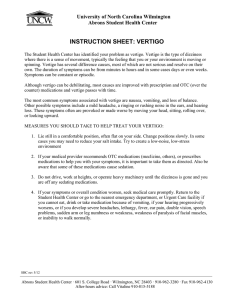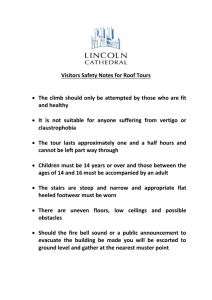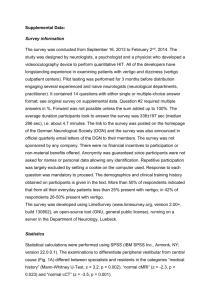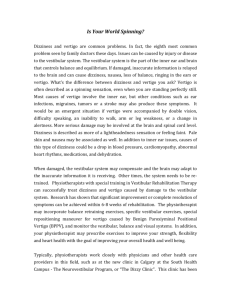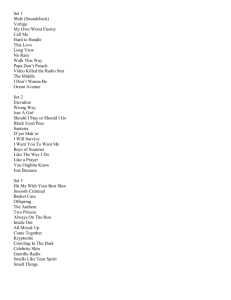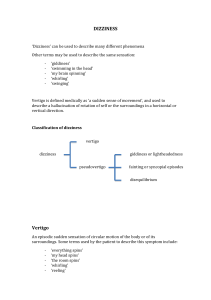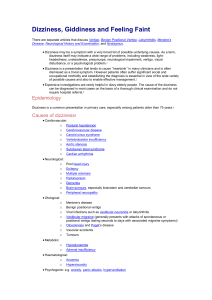Review articles and cohort studies were found through MEDLINE searches
advertisement
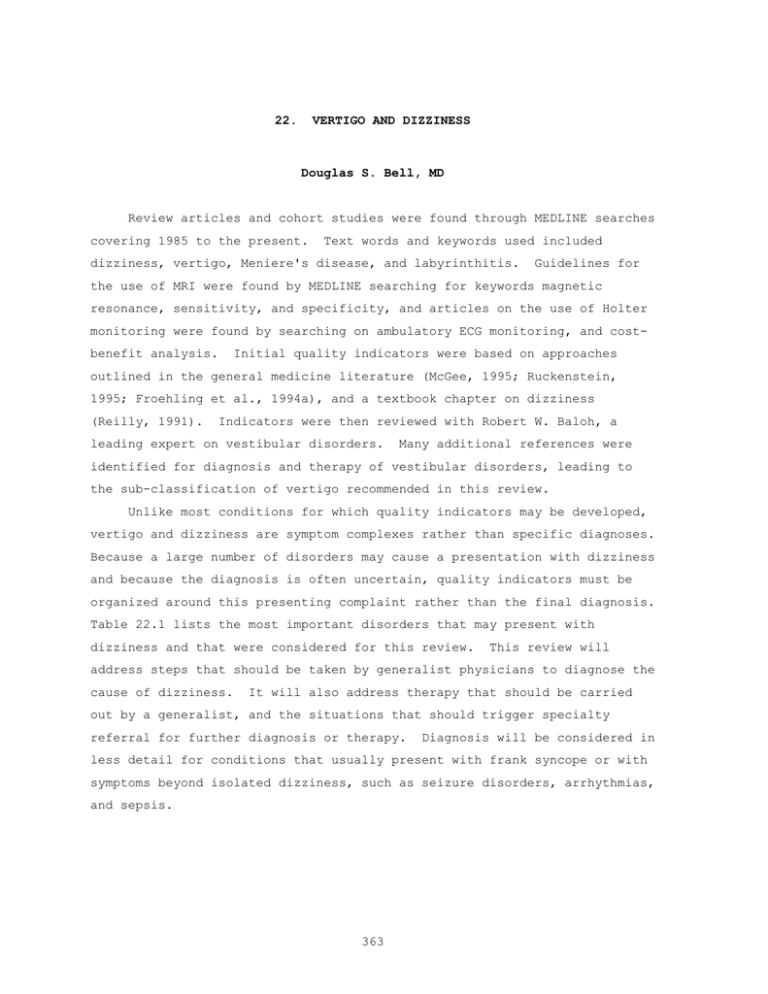
22. VERTIGO AND DIZZINESS Douglas S. Bell, MD Review articles and cohort studies were found through MEDLINE searches covering 1985 to the present. Text words and keywords used included dizziness, vertigo, Meniere's disease, and labyrinthitis. Guidelines for the use of MRI were found by MEDLINE searching for keywords magnetic resonance, sensitivity, and specificity, and articles on the use of Holter monitoring were found by searching on ambulatory ECG monitoring, and costbenefit analysis. Initial quality indicators were based on approaches outlined in the general medicine literature (McGee, 1995; Ruckenstein, 1995; Froehling et al., 1994a), and a textbook chapter on dizziness (Reilly, 1991). Indicators were then reviewed with Robert W. Baloh, a leading expert on vestibular disorders. Many additional references were identified for diagnosis and therapy of vestibular disorders, leading to the sub-classification of vertigo recommended in this review. Unlike most conditions for which quality indicators may be developed, vertigo and dizziness are symptom complexes rather than specific diagnoses. Because a large number of disorders may cause a presentation with dizziness and because the diagnosis is often uncertain, quality indicators must be organized around this presenting complaint rather than the final diagnosis. Table 22.1 lists the most important disorders that may present with dizziness and that were considered for this review. This review will address steps that should be taken by generalist physicians to diagnose the cause of dizziness. It will also address therapy that should be carried out by a generalist, and the situations that should trigger specialty referral for further diagnosis or therapy. Diagnosis will be considered in less detail for conditions that usually present with frank syncope or with symptoms beyond isolated dizziness, such as seizure disorders, arrhythmias, and sepsis. 363 IMPORTANCE Dizziness is a common presenting complaint, accounting for one percent of all office visits in 1989 (McGee, 1995). It is among the ten most frequent presenting complaints for women age 65 to 74 and men age 75 and older. Although most patients presenting with dizziness in primary care improve on their own, a significant minority of patients (44%) in one study had the same or worse symptoms at one-year follow-up (Kroenke et al., 1994). Ten percent of patients in that study had central vertigo that “may have” been due to cerebrovascular disease, though none had died at one year. Among patients presenting with dizziness to an emergency room, 31 percent had a “serious” cause (stroke, medication side effect, seizure, or arrhythmia). In a study of patients with dizziness over 70 years old presenting to a neurologist, 23 percent had brainstem or cerebellar ischemia (Sloane and Baloh, 1989). High quality medical care may therefore prevent serious disability in a few patients and help to improve symptoms in many. SCREENING Some of the underlying causes of dizziness may have an asymptomatic interval, but there is no evidence that diagnosing these conditions prior to the onset of dizziness would have any benefit. DIAGNOSIS Table 22.1 lays out the differential diagnostic considerations for dizziness. Prevalence statistics are taken from the cohort studies summarized in McGee (1995): 102 patients in a dizziness clinic, 100 patients in a primary care practice (Kroenke et al., 1992), 116 patients in a neurology clinic (Sloane and Baloh, 1989), and 123 patients in an emergency room (Herr et al., 1989). Less common disorders that were not reported in these studies but that should be considered in the differential diagnosis of dizziness are marked in Table 22.1 with an asterisk. may also have more than one cause of dizziness simultaneously. Patients A recent study of 117 men over age 50 presenting with dizziness to a general neurology clinic found that 49 percent had more than one contributing diagnosis (Davis, 1994). Patients with symptoms of more than one type of 364 dizziness should therefore have history, physical examination, and laboratory testing appropriate for each type. History The history provides crucial information for the initial classification of a patient's dizziness into one of four categories: vertigo, disequilibrium, presyncope, or nonspecific lightheadedness. For this reason, every patient presenting with dizziness should have documentation of symptoms that support at least one of these categories. Vertigo Vertigo is an illusion of movement, either of the person's body or of the environment. Words commonly used to describe the sensation include spinning, tilting, and moving sideways. Any patient with a final diagnosis in the vertigo category should have some abnormal sensation of movement documented. The many potential causes of vertigo are best distinguished by sub-classifying vertigo according the duration of symptoms, and whether the vertigo is brought on by changes in position or occurs spontaneously. Association of vertigo with hearing loss or tinnitus also provides important diagnostic information. Excellent quality care would therefore include documentation of these factors in the patient chart (Indicator 1) (Ruckenstein, 1995). We next consider the causes of each important sub- syndrome of vertigo. Details of making this subclassification are elaborated in Table 22.1. Recurrent positional vertigo Benign positional vertigo (BPV) is caused by otolithic debris floating free in the posterior semicircular canal (Epley, 1995). Vertigo occurs in episodes lasting less than a minute, initiated by sudden head movements. Central vertigo (which may result from many causes, including posterior fossa infarction, tumor, multiple sclerosis (MS), and carcinomatous cerebellar degeneration) may also rarely cause vertigo triggered by head movements, but episodes tend to last more than one minute (McGee, 1995). Vertigo is an initial complaint in five percent of patients first presenting with MS (Ruckenstein, 1995). 365 Differentiation between central and benign positional vertigo rests on the physical examination, as described in the next section. Recurrent spontaneous vertigo Posterior circulation transient ischemic attacks (TIAs) tend to cause spontaneous attacks of vertigo, with or without other neurologic symptoms, that last four to eight minutes (Grad and Baloh, 1989). A prior history of cerebrovascular disease or risk factors such as hypertension (HTN), diabetes mellitus (DM), and smoking may contribute to making this diagnosis (Indicator 2). Meniere's syndrome, or endolymphatic hydrops, causes acute- onset vertigo resolving gradually over hours to days and is often associated with unilateral hearing loss, tinnitus and a sensation of ear fullness. Prolonged spontaneous vertigo Vestibular neuritis (also incorrectly called labyrinthitis) causes abrupt onset of sustained vertigo lasting one to seven days. Acute, ongoing vertigo is also a “cardinal sign” of posterior circulation stroke, and vertigo is not always accompanied by other neurologic findings. In a case series of 153 patients with posterior circulation strokes, vertigo was present in 78 percent of cases (Fisher, 1967). In approximately one fourth of the cases with dizziness, it was the sole initial symptom, with other neurologic symptoms usually evolving over at most six weeks. Since the history may not differentiate vestibular neuritis from a posterior circulation vascular event in patients with acute persistent vertigo, the patient's risk factors for cerebrovascular disease are important to choosing further diagnostic testing. The chart should document some consideration of the patient's age, prior vascular disease, and history of HTN, DM, and smoking (Indicator 2)(Oas and Baloh, 1992; Ruckenstein 1995; Baloh et al., 1996). Case reports show that patients even in their 50s with significant vascular risk factors may have posterior circulation strokes heralded by episodes of isolated vertigo (Oas and Baloh, 1992). Rare causes of vertigo may also be distinguished by history. Perilymphatic fistula is an abnormal communication between the middle and inner ear that may be caused by head trauma, ear surgery, cholesteatoma, otosyphilis, and anomalies of the temporal bone. 366 It is suggested if vertigo is set off by changes in pressure, such as ascent in an airplane, valsalva, insufflation with an otoscope, or even loud noises (Ruckenstein, 1995; Baloh and Hamalgyi, 1996). A history of chronic otitis media may suggest cholesteatoma (Reilly, 1991). Significant ear pain with vertigo may suggest herpes zoster oticus (Reilly, 1991). Each of these conditions is rare enough, however, that requiring documentation of their consideration would probably not be productive as a quality indicator. Disequilibrium Disequilibrium is a sensation of unsteadiness, not localized to the head, that occurs when walking and that resolves at rest. The most common cause of disequilibrium is "multiple sensory deficits" in elderly patients, who may have reductions in vestibular, visual and proprioceptive function—all three of the balance-preserving senses. One characteristic of multiple sensory deficits is that symptoms will often resolve when the patient adds proprioceptive information by touching a wall or table (McGee, 1995). Risk factors for peripheral neuropathy and cerebellar degeneration should be elicited, including alcohol consumption, nutrition, diabetes mellitus, and family history (e.g., of porphyria or amyloidosis) (Indicator 3). Bilateral or gradual vestibular dysfunction usually causes disequilibrium rather than vertigo. Hearing loss would be associated with many causes of gradual vestibular dysfunction, such as acoustic neuroma, so hearing loss should be sought on history for disequilibrium as well as vertigo (Reilly, 1991). Presyncope Presyncope is the lightheadedness of a near-faint. This review does not cover patients with full loss of consciousness or syncope. Features of a patient’s dizziness may suggest specific diagnoses, so the following features should be documented: sudden onset of presyncope is suspicious for arrhythmia (Reilly, 1991); exertional presyncope classically suggests aortic stenosis; presyncope with emotional stress or on urination suggests more benign, vasomotor syncope. Presyncope on standing, or orthostatic hypotension, has an enormous differential diagnosis (Reilly, 1991) (Indicator 4). Clinically evident causes, such as pregnancy, advanced Parkinsonism, and sepsis, are beyond the scope of this review. 367 Medications are a common cause of orthostasis, especially diuretics but also vasodilators, tricyclic antidepressants, and many others. medication history is therefore necessary. A careful Peripheral neuropathy is also a common cause, most often from diabetes, but also potentially from rarer causes including amyloidosis and porphyria (Reilly, 1991). Other uncommon causes include hypoadrenalism and Shy-Drager syndrome. Nonspecific dizziness Many patients with dizziness have neither vertigo, disequilibrium, nor presyncope. These patients often cannot describe their symptoms beyond simply saying that they are "dizzy". Their history is distinguished mostly by its vagueness and the lack of any features that would point to causes in one of the other categories (Reilly, 1991). They may or may not have other nonspecific symptoms, such as a feeling of floating, disconnectedness, unreality, or fear of losing control. These patients tend to have a psychiatric disorder such as anxiety or panic disorder (Reilly, 1991). Among 16 patients in one study whose dizziness was considered to be due primarily to a psychiatric disorder, six had a mood disorder, seven had anxiety disorders including panic, nine had somatization disorder, and nine had personality disorders (Kroenke et al., 1992). than one diagnosis. Many patients had more A history of depressive symptoms (sadness, anhedonia, sleep pattern, loss of appetite, concentration disturbance, and suicidal ideation) and panic symptoms (diaphoresis, flushing, palpitations, chest pressure, paresthesias, and nausea) should be sought. Physical Examination Provocation maneuvers are the focus of the physical examination for dizziness but several routine elements of the exam should also be performed in each patient with dizziness. The tympanic membranes and external canals should be inspected with an otoscope for evidence of zoster, cholesteatoma, or other destructive process (Indicator 5) (Reilly, 1991). The cranial nerves should always document eye movements (for spontaneous and gazeevoked nystagmus), facial strength and sensation (for V and VII palsies from cerebellopontine angle tumor), and some assessment of hearing. movements are particularly important for differentiating central from Eye 368 peripheral causes of vertigo. origin (Fisher, 1967). Vertical nystagmus is always central in Spontaneous nystagmus from peripheral lesions should be unidirectional, increasing with gaze in the direction of the nystagmus and decreasing with gaze away. Central lesions, on the other hand, often cause nystagmus that changes direction with gaze in different directions (Baloh et al., 1996). Many generalists may be uncomfortable making this distinction, however. Patients with acute ongoing vertigo should therefore be referred to a neurologist or otolaryngologist unless the chart documents unidirectional nystagmus consistent with a peripheral lesion. Five provocation tests may help to categorize the diagnosis: the Hallpike maneuver, gait observation, Romberg testing, orthostatic BP and pulse, and hyperventilation for three minutes. One author recommends that each of these tests should be performed on every dizzy patient, since more than one diagnosis may coexist (Reilly, 1991). Given the lack of evidence for this approach and the time constraints of modern practice it seems more reasonable to require a provocative maneuver only when some element of the patient's history points toward its potential usefulness. The Hallpike maneuver (Dix and Hallpike, 1952), is also sometimes called (incorrectly) the Nylen-Baranay test after the authors who first described BPV (McGee, 1995). The procedure involves holding the patient's head in extension and rotation while moving the patient from a seated to a head-hanging supine position in less than two seconds. A positive test elicits vertigo and a practically pathognomonic torsional-vertical nystagmus, confirming the diagnosis of BPV (Indicator 6). A negative test does not rule out BPV, however, since spontaneous remissions and exacerbations are common. Inexperienced clinicians may have difficulty distinguishing BPV’s torsional vertical nystagmus from the pure vertical or horizontal nystagmus that may be found on Hallpike testing in central vertigo (McGee, 1995; Robert Baloh, personal communication). Case reports also suggest that BPV may be distinguished from central positional vertigo by the latency, duration, and fatigability of nystagmus elicited by Hallpike testing (see Table 22.1) (McGee, 1995). Patients who have nystagmus induced by Hallpike maneuver that does not have a clearly 369 torsional component should therefore be referred for neurologic consultation. Gait observation and Romberg testing should be undertaken in patients with disequilibrium (Indicator 9). Particular attention should be paid for signs of ataxia, foot drop, Parkinsonism, veering, and ease of correction (Reilly, 1991). Visual acuity should be checked and eyes examined for cataracts (McGee, 1995) (Indicator 8). Vital signs should be obtained in the supine, seated, and standing position for any patient suspected of having presyncopal episode (Reilly, 1991) (Indicator 7). A drop in BP of 10 mm systolic or rise in pulse rate more than 20 per minute indicates a positive test. A recent large cohort study showed that postural dizziness without significant changes in vital signs was even more strongly associated with future falls than true orthostatic hypotension (Ensrud et al., 1992). Postural dizziness should therefore be considered equivalent to postural hypotension. Some authors recommend asking the patient to hyperventilate for three minutes in an attempt to reproduce the patient's symptoms, with strict criteria for calling the test positive (Reilly, 1991). In prospective studies, however, the hyperventilation test has had relatively high false positive rates, though these studies may not have been as strict in interpreting the test results (Kroenke et al., 1992; McGee, 1995). In one prospective study the sensitivity was 100 percent but specificity only 79 percent for hyperventilation syndrome (Herr et al., 1989). Because the prevalence of hyperventilation syndrome was much lower than that of other diagnoses, the test had only a 19 percent positive predictive value. Its 100 percent negative predictive value would appear more useful, but since only five patients with hyperventilation syndrome were tested this statistic is also uncertain. Kroenke found a similarly poor specificity in a primary care practice (Kroenke et al., 1992). Given its inadequate specificity, this review will not recommend hyperventilation testing (Kroenke et al., 1992; McGee, 1995). Other maneuvers, including Valsalva, carotid sinus stimulation, and the Quix test for past-pointing showed little benefit in one trial (Herr et al., 1989). 370 Laboratory And Radiologic Testing Most patients with dizziness do not require laboratory or radiologic testing, the major exception being the need for neuroimaging in patients who may have posterior fossa tumors or strokes. Strokes are especially important to detect at initial presentation, since they can evolve to further deficits, brain swelling, and death. MRI should be the first imaging modality for disease in the posterior fossa, according to guidelines based on evidence of "moderate" quality (American College of Physicians, 1994). Patients with onset of vertigo associated with new neurological deficits such as dysarthria or numbness should definitely undergo MRI (Indicator 10). Imaging of patients who have spontaneous vertigo without other neurologic findings has more uncertain benefit. As noted above, the history and physical examination may not fully distinguish stroke from vestibular neuritis, but the prior probabilities of these disorders remain uncertain. A recent review (Froehling et al., 1994a) concluded that patients less than 70 years old with true vertigo and no other neurologic deficit may not need further testing, since a prospective study of ER patients with dizziness (Herr et al., 1989) found that only 12 percent of them had a 'serious' cause of dizziness (stroke, medication side effect, seizure, or arrhythmia). However, the authors later agreed with a correspondent who suggested that most physicians would not be comfortable accepting that they will miss 12 percent of serious causes in this setting (Froehling et al., 1994b). In deciding whether to obtain MRI, risk factors for cerebrovascular disease (HTN, diabetes, smoking, age > 65, and history of prior atherosclerotic vascular disease) should probably be considered, though evidence for the strength of risk factors in vertebrobasilar vascular disease is weak or nonexistent. A more conservative alternative to requiring MRI for patients with acute prolonged vertigo and any risk factors for cerebrovascular disease would instead require that such patients be referred to a neurologist for a more detailed neurologic assessment. MRI is not necessary for younger vertiginous patients without risk factors for cerebrovascular disease, especially with gaze-evoked nystagmus typical of a peripheral lesion. 371 CT scan of the head is recommended if normal pressure hydrocephalus (NPH) is suspected (American College of Physicians, 1994). Patients with a history of disequilibrium, gait imbalance, and new dementia or incontinence should therefore have a head CT. NPH is a rare disorder, however, so its detection is probably not warranted as a quality indicator. Audiometry is the test of first choice for any patient with suspected acoustic neuroma (Ruckenstein, 1995). Acoustic neuroma causes imbalance far more often than vertigo, however, so our quality indicator requires audiometry for patients with a history of hearing loss with disequilibrium or vertigo (Indicator 11). Audiometry often shows a characteristic low- frequency hearing loss in Meniere’s disease (Baloh et al., 1996). Audiometry may also aid in the diagnosis of vestibular neuritis, ototoxic medications, and spinocerebellar degeneration. This broad utility has led to the recommendation that it be used as a screening test for every patient with non-positional vertigo (Robert Baloh, personal communication). Because the operating characteristics of audiometry remain uncertain, however, no further quality indicators will be specified for audiometry. Electronystagmogram (ENG) has been recommended for confirming vestibular damage in Meniere's disease and aminoglycoside ototoxicity (Ruckenstein, 1995; Baloh et al., 1996), but ENG testing has had problems with poor quality control (Robert Baloh, personal communication). Another author states that ENG usually only confirms diagnoses "obvious" from the history and physical (Reilly, 1991). This review makes no recommendations for quality indiators for ENG. Electrocardiograms (ECGs) should be performed on patients with potential arrhythmias. Such patients would include those with sudden presyncope episodes with or without palpitations, and those with ongoing lightheadedness and tachycardia or bradycardia on examination (Indicator 12). Patients with episodic presyncope should also be considered for ambulatory ECG (Holter) or event monitoring. In one study of Holter monitoring, the test resulted in a management change in 29 percent of patients with dizziness and palpitations, and seven percent of patients with dizziness without palpitations (Kessler et al., 1995). A small randomized crossover trial in patients with palpitations found that Holter 372 monitors detected no clinically significant arrhythmias while event monitors detected significant arrhythmias in 19 percent (Kinlay et al., 1996). Hemoglobin and hematocrit (H&H) testing has been recommended for patients with orthostatic hypotension to identify occult anemia (Reilly, 1991). Several case series support the utility of the H&H in this setting (Davis, 1994; Herr et al., 1989; Madlon-Kay, 1985). Testing for the many less common causes of orthostatic hypotension, such as hypoadrenalism would also make sense if symptoms persist, but this review will not recommend further quality indicators. TREATMENT Ninety percent of patients with dizziness leave the physician's office with a prescription, often for meclizine, while four percent are referred to specialists (McGee, 1995). Only two small randomized placebo-controlled trials of meclizine are quoted in our review articles, one supporting the effectiveness of meclizine based on 31 patients with vertigo, and the other supporting meclizine combined with dimenhydrinate in 50 elderly patients with dizziness from a variety of causes (McGee, 1995). Animal studies, however, show that vestibular suppressant medications actually hinder recovery from a vestibular insult by suppressing the vestibular input from the uninjured side that is essential for recovery (Peppard, 1986). Meclizine therefore probably does more harm than good (Robert Baloh, personal communication), but given the uncertainty of evidence this review will not suggest quality indicators for or against meclizine. For BPV, the canalith repositioning procedure, or Epley's maneuver, is safe and effective. This maneuver takes the patient through a series of head positions to return debris from the semicircular canal into the utricle where its movement ceases to cause vertigo. In the initial case series of 30 BPV patients treated with the procedure, 90 percent had immediate complete resolution of vertigo. The remaining ten percent had full resolution of positional vertigo, but only partial relief of vertigo overall. Though 30 percent later had one or more recurrences, 86 percent of these had complete resolution on retreatment (Epley, 1992). 373 At another institution, 19 of 25 patients with BPV (76%) had complete resolution of symptoms from the canalith repositioning procedure (Welling and Barnes, 1994). Other recent randomized trials have yielded similar results (Lynn, et al. 1995; Li, 1995; Blakeley, 1994; Herdman, et al. 1993). Patients can also be given an instruction page teaching them to perform this maneuver on themselves should their symptoms recur (Baloh et al., 1996). The best treatment for BPV prior to Epley’s maneuver consisted of head movement exercises that repeatedly precipitated symptoms with the intent of dispersing debris within the semicircular canal. This led to complete relief in 66 of 67 patients within three to 14 days (Brandt and Daroff, 1980). These exercises often induce nausea and vomiting, however, and must be performed several times a day to be effective. Thus patients outside of trials may fail to complete the course and continue to have vertigo (Baloh, personal communication). Given the simplicity of the canalith repositioning procedure and the marked differences in the time spent ill between the two treatments, this review recommends as a quality indicator the canalith repositioning procedure be used as the standard treatment for BPV (Indicator 13). Treatment of Meniere's disease has been difficult to evaluate because the disease has a naturally remitting and relapsing course, though it usually progresses over ten to 20 years to severe permanent hearing loss (2/3 unilateral). Vertigo episodes stop when this “burned out” stage of Meniere’s is reached (Baloh et al., 1996). Guidelines for treatment of Meniere’s disease from the American Academy of Otolaryngology recommend sodium restriction to 1–2 g/day in combination with a diuretic such as hydrochlorothiazide (HCTZ) (Santos et al., 1993). A retrospective case series of 26 patients who reported compliance with this regimen found that hearing loss stabilized and vertigo improved during an average follow-up of six years (Santos et al., 1993). Better evidence for diuretic use comes from a randomized double-blind crossover trial in 30 patients that found modest improvement in episodes of vertigo and hearing loss when patients were on HCTZ rather than placebo (Klockhoff and Lindblom, 1967). Another retrospective series, however, emphasized salt restriction (Boles et al., 1975). Some experts recommend that salt restriction should be initiated 374 first and diuretics added only if episodes of vertigo continue (Baloh et al., 1996). Given the incomplete evidence this review recommends that medical therapy for Meniere’s disease include either salt restriction or diuretic therapy or both (Indicator 14). Surgery may be contemplated for the occasional patient with disabling, refractory vertigo. Endolymphatic shunt surgery was once widely performed, and is still recommended by some authors (Ruckenstein, 1995), but it has gradually fallen out of favor after two negative trials. Shunt surgery was no better than sham mastoidectomy in one trial (75 percent of patients in both groups had improved at 3 years), and had no better outcome than those who refused surgery in another trial (60 percent of patients in both groups had improved at two years) (McGee, 1995). A more logical surgery for debilitating, refractory Meniere’s disease is simple ablation of vestibular function on the affected side so that the central nervous system can complete the process of compensation (Baloh et al., 1996). Options are either selective section of the vestibular nerve, or a chemical vestibulectomy created by infusing gentamycin into the middle ear. A six to 12 month trial of medical therapy would generally be reasonable before proceeding to surgery (Baloh, personal communication). Because there is no clear consensus on appropriate surgery for Meniere’s disease, however, our indicators will not address this topic. Patients with prolonged vertigo probably benefit from vestibular rehabilitation therapy (VRT), though evidence remains meager and no quality indicators are recommended (Baloh et al., 1996). A randomized trial of head turning/visual fixation exercises and gait exercises in 21 patients after acoustic neuroma resection found markedly better gait and balance after three days of VRT compared with less specific exercises (Herdman et al., 1995). This benefit may be generalizable to other acute peripheral lesions such as vestibular neuritis. VRT is less effective in patients whose vertigo is due to head trauma or bilateral ototoxicity, though in the latter case a controlled trial has shown that the benefit is still statistically significant (Shepard and Telian, 1995). central vertigo, (e.g. Patients with from stroke or multiple sclerosis) have more difficulty adapting to loss of vestibular function. 375 Though VRT has not been systematically studied in this group (Shepard and Telian, 1995), they almost certainly benefit at least from gait training (Baloh et al., 1996). Patients with multiple sensory deficits should have their deficits addressed wherever possible (McGee, 1995). Patients with visual impairment should therefore have referral for ophthalmologic evaluation (Indicator 16), and patients with significant gait disorder or proprioceptive loss should be referred to physical therapy for gait and balance training, and consideration of the use of a walker. Most cases of orthostatic hypotension require treatment of the underlying cause, most commonly the discontinuance of offending medications. Other common causes of orthostatic hypotension, such as peripheral neuropathy due to diabetes, do not have specific treatments. Many cases of orthostatic hypotension also remain idiopathic. Treatment of these patients may initially be nonpharmacologic (e.g., avoiding dehydration, salt supplements, support stockings) and may progress to mineralocorticoid therapy (Reilly, 1991; see Tables 5-11 and 5-12 in this reference). The treatment of more serious conditions, such as brainstem infarction or cardiac arrhythmia, would typically be carried out by a specialist and is beyond the scope of this review. Although many cases of anxiety and depression may be treated by a primary care physician, their treatment is also beyond the scope of this review (see Chapter 8 for indicators related to treatment of depression). FOLLOW-UP There are no specific recommendations in the literature for follow-up of patients with dizziness. Since many of the treatments outlined above require empiric adjustments it would make sense to schedule regular followup, but given the lack of evidence this review will not create quality indicators for follow-up. 376 Table 22.1 Differential Diagnostic Considerations for Dizziness ‘*’ indicates conditions that were not assigned a prevalence in existing cohort studies of patients presenting with dizziness. Cause Vertigo Benign positional vertigo (BPV) Central vertigo (posterior circulation CVA, MS, cerebellopontine angle tumor, and many more). Prevalence (%) Key History 38–46 Illusion of movement 12–26 Vertigo in episodes lasting seconds, provoked by changes in position, like turning in bed, or reaching for a high shelf. (Syndrome: Recurrent positional vertigo) 2-3 Acute disorders (e.g. CVA) cause sustained vertigo (syndrome: prolonged spontaneous vertigo). Slowgrowing tumors cause imbalance, but minimal, if any, vertigo. 5% of MS initially presents with vertigo. 377 Key Physical Exam Nystagmus Hallpike test: torsional- vertical nystagmus should have 2–20 sec. latency, adapt in less than 50 sec., and lessen with prompt repetition. Usually directionchanging gaze-evoked nystagmus. Hallpike nystagmus is typically pure vertical or horizontal, has no latency, and does not fatigue; Acoustic neuroma always has at least some hearing loss; sometimes V, VII palsy. Testing MRI of posterior fossa; Audiometry. III Cause Vertebrobasilar TIA Prevalence (%) Key History Key Physical Exam 5–7 Acute spontaneous episodes of Exam is usually normal. vertigo lasting minutes (typically 4-8 min). (syndrome: Recurrent spontaneous vertigo) Associated neurologic symptoms (numbness, diplopia, etc.) frequent. Risk factors: age, HTN, DM, smoking, anticoagulation. Meniere's syndrome 3–8 Vertigo in spontaneous episodes, lasting hours, with hearing loss, tinnitus, unilateral ear fullness. (Syndrome: Recurrent spontaneous vertigo). Spontaneous torsional horizontal nystagmus, only during an acute attack. Vestibular neuritis (Labyrinthitis) 3–9 Acute sustained vertigo, lasting 1-7 days or longer, without hearing loss. Recent febrile illness in 25–50% (Syndrome: Prolonged spontaneous vertigo). Spontaneous unidirectional torsional-horizontal nystagmus. Decreased caloric responses in the affected ear. Nystagmus suppressed by visual fixation. 378 Testing Vertebrobasilar MR angiography only helpful if dx uncertain, e.g., if good history but few risk factors. Audiometry: Low frequency loss is highly specific. Audiometry MRI not necessary. Cause Other, including: migraine Prevalence (%) 7-10 Next to BPV, most common cause. Key History Vertigo in spontaneous episodes, lasting hours, headache may be dissociated (Syndrome: Recurrent spon-taneous vertigo). Up to 25% of migraines are associated with vertebrobasilar symptoms. Usually no vertigo with bilateral vestibular insult. Instead, dis-equilibrium and oscillopsia (vision unsteady with head movements). Key Physical Exam Usually normal. Audiometry. Bilateral hearing decrement, except with aminoglycosides, which do not affect hearing. Audiometry. Ototoxic medications * Cholesteatoma * Prolonged spontaneous vertigo. Visualization of the History of chronic otitis tympanic membrane media. Conductive hearing loss. Otorrhea. Perilymphatic fistula * Herpes zoster oticus * Vertigo set off by air pressure changes or straining. (Recurrent pressure-provoked vertigo) RFs: head trauma, otosyphilis, congenital temporal bone anomaly. Prolonged spontaneous vertigo. Hearing loss. In full Ramsay Hunt syndrome, ear pain & facial paralysis. Unsteady walking. Disequilibrium 379 Testing Nystagmus and vertigo from otoscope insufflation. Vesicles on the TM or canal ± facial paralysis. Gait testing. Cause Multiple sensory deficits Prevalence (%) Key History 1–17 No dizziness at rest. Relieved when touching wall. Ototoxic medications Peripheral Neuropathy up to 5 Key Physical Exam Gait testing with rightangle turns; Romberg Visual acuity, fundoscopy for cataracts, macular degeneration. Usually no vertigo with bilateral vestibular insult. Instead, dis-equilibrium and oscillopsia (vision unsteady with head movements). Bilateral hearing decrement, except with aminoglyco-sides, which do not affect hearing. Risk factors: alcohol, DM, toxins, vitamin deficiency. Romberg positive Sensory loss, decreased deep tendon reflexes. Cerebellar disease or spinocerebellar disease * Slow posterior fossa neoplasms Ataxia, dysmetria, etc. cause imbalance rather than vertigo. Normal Pressure Hydrocephalus * Incontinence. Wide-based gait, extensor plantar reflex. Testing Audiometry III. Audiometry if any hearing loss. CT or MRI. Presyncope 3–16 Impending faint. Orthostatic vitals. Orthostatic hypotension (incl. meds, infection) 2–7 Dizziness occurs after assuming upright posture. Upright drop in BP or dizzy symptoms. Rectal for occult blood. CBC. Abrupt onset; ± palpitations. If ongoing, tachycardiaor bradycardia ECG;Holter / event monitor. Arrhythmia up to 5 380 Cause Vasomotor or "vasovagal" Prevalence (%) Key History * History of prior similar episodes; +/- emotional stress. Other cardiac (AS, PE, etc.) * Exertional symptoms for AS Risk factors for PE. Situational (e.g. micturition) 1 History of events surrounding episode. Nonspecific lightheadedness Psychiatric (Anxiety, depression, panic, somatization) Hyperventilation Key Physical Exam Heart exam (murmur, rub). None of the above syndromes. 6–16 1–23 Hard to describe. May feel floating, disembodied, head fullness. Life stress. Panic syndrome: palpitations, doom sensation, diaphoresis. Circumoral and acral paresthesias may be present. Other panic symptoms. 381 DSM criteria for depression or panic on mental status exam. 3 minute hyperventilation: positive predictive value = 20% Testing REFERENCES American College of Physicians. 1994. Magnetic resonance imaging of the brain and spine: a revised statement. Archives of Internal Medicine 120: 872-5. Baloh RW, Fife TD, Furman JM, and Zee DS. 1996. Neurotology, Part A. Continuum: Lifelong Learning in Neurology. Minneapolis: American Academy of Neurology. Baloh RW, and G. Halmagyi. 1996. Disorders of the Vestibular System. New York: Oxford University Press. Bernard ME, Bachenberg TC, and Brey RH. 1996. Benign paroxysmal positional vertigo: the canalith repositioning procedure. American Family Physician 53: 2613-6, 2621. Blakeley BW. 1994 April. A randomized, controlled assessment of the canalith repositioning maneuver. Otolaryngology - Head and Neck Surgery 110(4):391-6. Boles R, Rice DH, Hybels R, and Work WP. July 1975. Conservative management of Meniere's disease: Furstenberg regimen revisited. Annals of Otology, Rhinology and Laryngology 84 ((4 Pt 1)): 513-7. Brandt T, and Daroff RB. August 1980. Physical therapy for benign paroxysmal positional vertigo. Archives of Otolaryngology 106 (8): 484-5. Davis LE. 1994. Dizziness in elderly men. Journal of the American Geriatric Society 42: 1184-8. Dix M, and Hallpike C. 1952. The pathology, symptomatology, and diagnosis of certain common disorders of the vestibular system. Proceedings of the Royal Society of London 45: 341–54. Ensrud KE, Nevitt MC, Yunis C, Hulley SB, et al. 1992. Postural hypotension and postural dizziness in elderly women. The study of osteoporotic fractures. The Study of Osteoporotic Fractures Research Group. Archives of Internal Medicine 152: 1058-64. Epley J. 1992. The canalith repositioning procedure for treatment of benign paroxysmal positional vertigo. Otolaryngoly - Head and Neck Surgery 107: 399–404. Epley J. 1995. Positional vertigo related to semicircular canalithiasis. Otolaryngology - Head and Neck Surgery 112: 154–61. 382 Fisher C. 1967. Vertigo in cerebrovascular disease. Archives of Otolaryngology 85: 529–34. Froehling DA, Silverstein MD, Mohr DN, and Beatty CW. 1 1994. Does this dizzy patient have a serious form of vertigo? Journal of the American Medical Association 271: 385-8. Grad A, and Baloh RW. 1989. Vertigo of vascular origin: clinical and electronystagmographic features in 84 cases. Archives of Neurology 46: 281-284. Herdman SJ, Tusa RJ, Zee DS, et al. 1993 April. Single treatment approaches to benign paroxysmal positional vertigo. Archives of Otolaryngology - Head and Neck Surgery 119 (4):450-4. Herdman SJ, Clenandiel RA, Mattox DE, et al. 1995. Vestibular adaptation exercises and recovery: acute stage after acoustic neuroma resection. Otolaryngology - Head and Neck Surgery 113: 77-87. Herr RD, Zun L, and Mathews JJ. 1989. A directed approach to the dizzy patient. Annals of Emergency Medicine 18: 664-72. Hoffman R, Einstadter D, and Kroenke K. 30 August 1996. Diagnosing Dizziness. From the Section of General Internal Medicine, Albuquerque VA Medical Center and the Dept. of Medicine, Univeristy of New Mexico School of Medicine; Sectional of General Internal Medicine, MetroHealth Medical Center and the Departement of Medicine, Case Western University; Division of General Internal Medicine and the Department of Medicine, Uniformed Services University of the Health Sciences. Kent DL, Haynor DR, Longstreth WT, et al. 1994. The clinical efficacy of magnetic resonance imaging in neuroimaging [see comments]. Archives of Internal Medicine 120: 856-71. Kessler DK, Kessler KM, and Myerburg RJ. 1995. Ambulatory electrocardiography. A cost per management decision analysis. Archives of Internal Medicine 155: 165-9. Kinlay S, Leitch JW, Neil A, et al. 1996. Cardiac event recorders yield more diagnoses and are more cost-effective than 48-hour Holter monitoring in patients with palpitations. A controlled clinical trial. Archives of Internal Medicine 124: 16-20. Klockhoff I, and Lindblom U. 1967. Meniere's disease and hydrochlorothiazide--A critical analysis of symptoms and therapeutic effects. Acta Otolaryngology 63: 347–65. Kroenke K, Hoffman R, and Einstadter D. How Common are Various Causes of Dizziness? A critical review of the literature. Regenstref Institute for Health Care, Albuquerque VA and Medical Center, MetroHealth 383 Medical Center, and the Clinical Efficacy Assessment Program of the American College of Physicians Kroenke K, and Hoffman R. 1997. A Rational Approach to the Dizzy Patient. Journal of Clinical Outcomes Management 4: 23-41. Kroenke K, Lucas CA, Rosenberg ML, et al. 1992. Causes of persistent dizziness. A prospective study of 100 patients in ambulatory care. Archives of Internal Medicine 117: 898-904. Kroenke K, Lucas C, Rosenberg ML, et al. 1994. One-year outcome for patients with a chief complaint of dizziness. Journal of General Internal Medicine 9: 684-9. Lempert T, Gresty MA, and Bronstein AM. 1995. Benign positional vertigo: recognition and treatment. British Medical Journal 311: 489-91. Li JC. 1995. Mastoid oscillation: a critical factor for success in canalith repositioning procedure. Otolaryngology - Head and Neck Surgery 112(6):670-5. Lynn S, Pool A, Rose D, et al. 1995 Dec. Randomized trial of the canalith repositioning procedure. Otolaryngology - Head and Neck Surgery 113(6):712-20. .Madlon-Kay DJ. 1985. Evaluation and outcome of the dizzy patient. Journal of Family Practice 21: 109-13. McGee SR. 1995. Dizzy patients. Diagnosis and treatment [see comments]. Western Journal of Medicine 162: 37-42. Oas JG, and Baloh RW. 1992. Vertigo and the anterior inferior cerebellar artery syndrome. Neurology 42: 2274-9. Peppard SB. 1986. Effect of drug therapy on compensation from vestibular injury. Laryngoscope Aug, 96 (8): 878-98. Reilly B. 1991. Dizziness. In Practical Strategies in Outpatient Medicine. Philadelphia: Saunders, pp. 162–236. Ruckenstein MJ. 1995. A practical approach to dizziness. Questions to bring vertigo and other causes into focus. Postgraduate Medicine 97: 70-2, 75-8, 81. Santos PM, Hall RA, Snyder JM, et al. 1993. Diuretic and diet effect on Meniere's disease evaluated by the Committee on Hearing and Equilibrium guidelines. Otolaryngology - Head and Neck Surgery 109: 680-689. Shepard NT, and Telian SA. 1995. Programmatic vestibular rehabilitation. Otolaryngology - Head and Neck Surgery 112: 172-182. 384 Sloane P, and Baloh R. 1989. Persistent dizziness in geriatric patients. Journal of the American Geriatric Society 37: 1031–8. Welling D, and Barnes D. 1994. Particle repositioning procedure for benign paroxysmal positional vertigo. Laryngoscope 104: 946–9. 385 RECOMMENDED QUALITY INDICATORS FOR VERTIGO AND DIZZINESS The following indicators apply to men and women age 18 and older. Indicator Diagnosis 1. Patients who present with vertigo1 should have all of the following documented at the time of initial presentation with symptoms: a. the duration of episodes; b. presence or absence of precipitation by head movements; c. presence or absence of any association with hearing loss or tinnitus. 2. Patients who present with prolonged spontaneous vertigo2 should have documentation of risk factors for cerebrovascular disease 3 at the time of presentation. 3. Patients who present with disequilibrium4 should have all of the following documented at the time of initial presentation: a. presence or absence of diabetes; b. presence or absence of alcohol consumption; c. use of ototoxic medications; d. recent poor oral intake. 4. Patients who present with presyncope 4 should be asked about all of the following possible precipitants at the time of initial presentation: a. standing up; b. urination; c. exertion; d. emotional stress. Quality of Evidence Literature Benefits III Ruckenstein, 1995 Prevent morbidity leading from incorrect diagnosis. Characteristics of vertigo are key to further diagnosis. III Baloh et al., 1996; Oas and Baloh, 1992; Ruckenstein, 1995 Prevent evolution of stroke, posterior fossa edema, and death. Critical to choosing further testing and treatment, since exam may not fully differentiate neuritis from CVA. III Reilly, 1991 Prevent disabling falls. Sensory loss due to peripheral neuropathy may be correctable. Poor oral intake can cause orthostasis. III Reilly, 1991 Reduce morbidity and death by identifying causes for presyncope. History guides further testing. 386 Comments 5. 6. 7. 8. 9. 10. 11. Indicator Patients who present with vertigo should have documented an examination of tympanic membranes at the time of presentation. Patients who present with recurrent positional vertigo 5 should have documented the results of a Hallpike maneuver6 at the time of presentation. Patients who present with presyncope should have all of the following documented at the time of presentation: a. orthostatic vital signs; b. heart examination. Patients who present with disequilibrium should have documentation of visual acuity testing at the time of presentation. Patients who present with disequilibrium should have documentation of the following components of a neurological examination at the time of presentation: a. cerebellar exam; b. gait observation; c. Romberg testing. Patients who present with vertigo and new neurological deficits should have MRI within 2 weeks of presentation. Patients who present with disequilibrium and unilateral hearing loss7 should have audiometry within 3 weeks of presentation. Quality of Evidence III Literature Ruckenstein, 1995 Benefits Decrease morbidity. Comments Examination can lead to diagnosis of cholesteatoma and herpes zoster oticus -which are rare, but easy to diagnose. II-2 McGee, 1995; Baloh et al., 1996 Decrease morbidity. Benign positional vertigo is immediately treatable. Central vertigo is usually serious and requires referral. III McGee, 1995 Decrease morbidity and mortality. Orthostasis is a very common cause of presyncope, but one also needs to consider serious arrythmias. III Reilly, 1991; McGee, 1995 Prevent disabling falls. Cataract extraction may cure some cases of disequilibrium. III McGee, 1995 Prevent disabling falls. Some sensory loss or disequilibrium may be correctable, especially through physical therapy. III American College of Physicians, 1994 Ruckenstein, 1995 Prevent evolution of CVA and decrease morbidity. Decrease morbidity from CPA tumor. Patients with acute onset of deficits should be considered for emergent MRI. III 387 Documentation of hearing loss needed prior to surgery for acoustic neuroma. Indicator 12. Patients who present with sudden presyncope 8 and HR < 55 on exam should have an ECG at the time of presentation. Treatment 13. Patients who present with torsional7 vertical nystagmus on Hallpike testing should have the canalith repositioning procedure within 1 week of presentation. 14. 15. 16. Patients who present with a diagnosis of Meniere's syndrome should be advised to follow a 1–2 gram sodium/day diet or be given a diuretic or both within one month of presentation. Patients who present with recurrent spontaneous vertigo9 and any risk factor 3 for cerebrovascular disease should start aspirin or ticlopidine at the time of presentation or be referred to a neurologist within 2 weeks of presentation. Patients who present with disequilibrium and decreased visual acuity should be referred to an opthalmologist or optometrist within one month of presentation. Quality of Evidence III Literature Reilly, 1991 Benefits Prevent mortality and decrease morbidity. Bernard et al, 1996; Lempert et al, 1995; Lynn, 1995; Li, 1995; Blakeley, 1994 Santos et al., 1993 Klockhoff & Lindblom, 1967 Decrease disability from symptoms of vertigo. Canalith repositioning is 76–100% effective. The 30% who recur can be retreated. Decrease disability from symptoms of vertigo. A small but randomized controlled trial supports HCTZ. II-2 Grad and Baloh, 1989 Prevent CVA. Twelve of 42 Patients 28% with posterior circulation stroke had prior vertigo TIAs. III Reilly, 1991; McGee, 1995 Prevent disabling falls. Cataract extraction may cure some cases of disequilibrium. I, II-2 I, II-2 388 Comments Definitions and Examples 1 Vertigo: an illusion of movement. 2 Prolonged spontaneous vertigo: Continuous vertigo, either ongoing or resolved only after several days. 3 High risk for stroke (CVD) includes one or more of the following risk factors: a. Prior stroke b. Diabetes mellitus c. Hypertension -- any of the following: • At least three measurements on different days with a mean SBP>140 mm Hg and/or a mean DBP>90 mm Hg documented in the medical record • A diagnosis of hypertension mentioned in the chart • Documentation of chronic antihypertensive therapy d. Age >65 years old e. Heart failure — any charted diagnosis of heart failure f. Clinical coronary heart disease (angina or myocardial infarction mentioned in the chart) g. Mitral stenosis h. Prosthetic heart valves i. Echo criteria: • Left atrial enlargement (>4.5 cm) • Impaired left ventricular function (ejection fraction <50% or LV dyskinesis, hypokinesis, or akinesis). 4 Presyncope: a sensation of impending faint. 5 Recurrent positional vertigo: Vertigo, recurring in episodes brought on by changes in head position, often lasting seconds. 6 Hallpike maneuver (also sometimes called the Nylen-Baranay test): The procedure involves holding the patient's head in extension and rotation while moving the patient from a seated to a head-hanging supine position in less than two seconds. 7 Hearing loss: any noticeable decrease in aural acuity. 8 Sudden presyncope: presyncope occurring in sudden, unprovoked episodes. 9 Recurrent spontaneous vertigo: Vertigo, recurring and abating spontaneously in episodes lasting minutes to hours. 389
